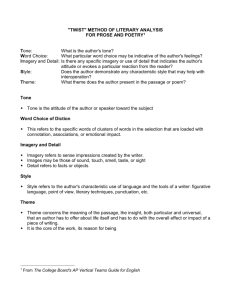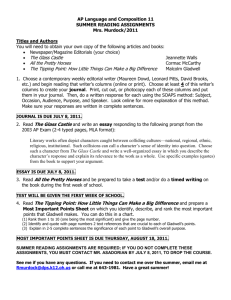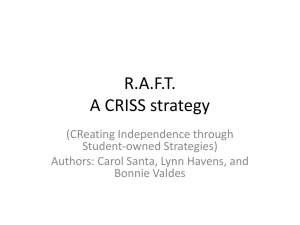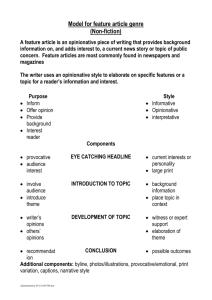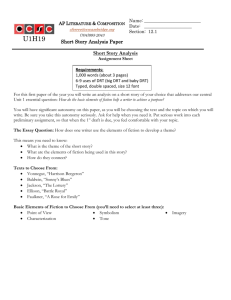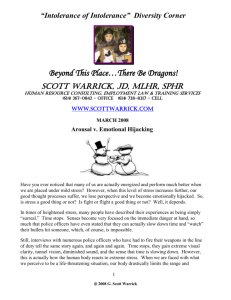CRCT Study Guide Handout
advertisement
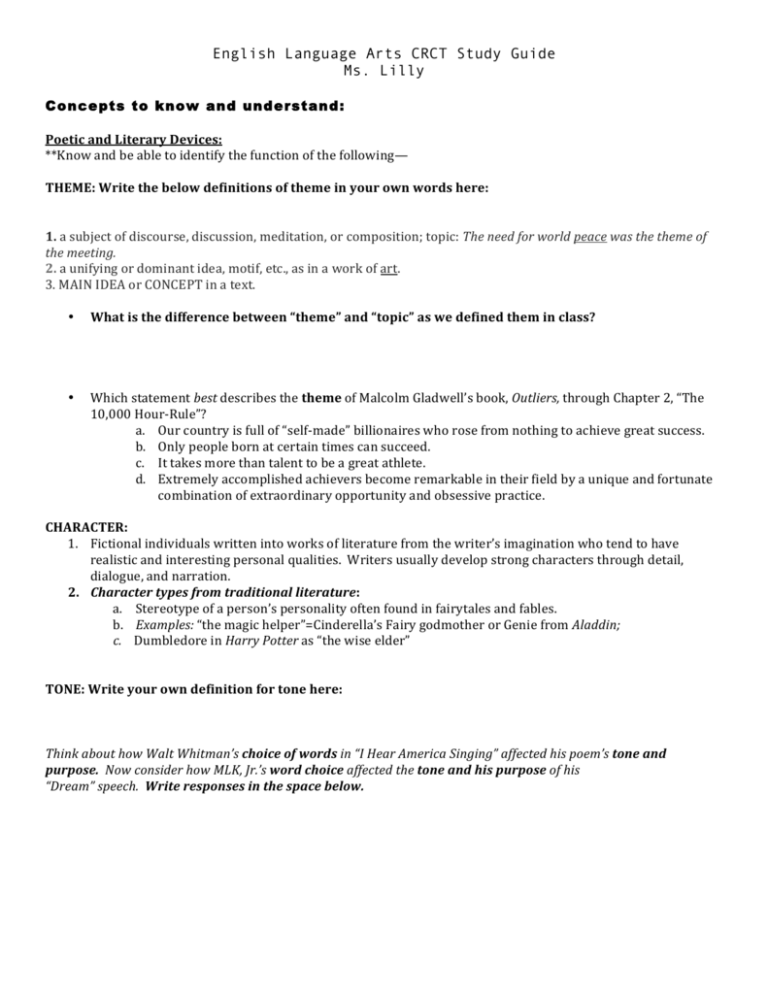
English Language Arts CRCT Study Guide Ms. Lilly Concepts to know and understand: Poetic and Literary Devices: **Know and be able to identify the function of the following— THEME: Write the below definitions of theme in your own words here: 1. a subject of discourse, discussion, meditation, or composition; topic: The need for world peace was the theme of the meeting. 2. a unifying or dominant idea, motif, etc., as in a work of art. 3. MAIN IDEA or CONCEPT in a text. • What is the difference between “theme” and “topic” as we defined them in class? • Which statement best describes the theme of Malcolm Gladwell’s book, Outliers, through Chapter 2, “The 10,000 Hour-­‐Rule”? a. Our country is full of “self-­‐made” billionaires who rose from nothing to achieve great success. b. Only people born at certain times can succeed. c. It takes more than talent to be a great athlete. d. Extremely accomplished achievers become remarkable in their field by a unique and fortunate combination of extraordinary opportunity and obsessive practice. CHARACTER: 1. Fictional individuals written into works of literature from the writer’s imagination who tend to have realistic and interesting personal qualities. Writers usually develop strong characters through detail, dialogue, and narration. 2. Character types from traditional literature: a. Stereotype of a person’s personality often found in fairytales and fables. b. Examples: “the magic helper”=Cinderella’s Fairy godmother or Genie from Aladdin; c. Dumbledore in Harry Potter as “the wise elder” TONE: Write your own definition for tone here: Think about how Walt Whitman’s choice of words in “I Hear America Singing” affected his poem’s tone and purpose. Now consider how MLK, Jr.’s word choice affected the tone and his purpose of his “Dream” speech. Write responses in the space below. **Define and write examples of the following devices that you’ve found in any text we’ve studied. Simile: writer’s tool used to make a reader consider an idea or object as it appeals to the reader’s senses • Definition— • Simile Example— Metaphor: less obvious, subtle, writer’s device used to make a reader consider an idea or object as it appeals to the senses • Definition— • Example— Reading Skills: Inference (Write definition here): What does it mean to make an inference about something you’ve read? Based on what you’ve read in Outliers, you can infer that— a. Malcolm Gladwell believes that Jeb Bush is a self-­‐made politician. b. Anyone who meets the “10,000 Hour Rule” in his or her field of work will become incredibly successful. c. Malcolm Gladwell does not enjoy analyzing the background of exceptionally high achievers because their stories are all the same: they had incredible opportunities, decent talent, and prepared their skill for over 10,000 hours. d. Malcolm Gladwell considers human history—our culture, inventions, art, and belief systems—too complex to be easily explained or defined. Structure of a Text: poetry, prose, fiction, and informational pieces **A text’s STRUCTURE usually contributes to the Writer’s Purpose or main argument. o For example, the purpose of a speech (think MLK, Jr.’s “Dream” speech) is usually to inform and inspire an audience o The purpose of a chart or graph is to inform viewers of data, perhaps by outlining the steps in a process (chronological) or plotting the progress of growth over a period of time. o The purpose of a magazine’s movie review section is to give readers a summary of the film so that readers can decide whether this is a movie they’re interested in paying to see, or even watch at all. The same thing goes for most book and record reviews—they’re summaries that give audiences a general idea of the piece’s important and/or unimpressive qualities. What is a stanza in poetry? What is the difference between a poetic stanza and a paragraph? How do you think the length and organization of both a paragraph and a stanza could help a writer achieve his purpose for completing his piece? Some Common Structure Types Found in Prose (WRITING THAT IS NOT POETRY)— • Chronological Order: Writing that describes events in the exact sequence that they occur in the present, or as they did occur in the past. Can be in a fictional or informational text. Will often use words like: “First”; “Then”; “Next” and “Finally.” • Cause and Effect: describes how a circumstance creates an outcome. o For example-­‐-­‐“because I put my hand on the hot iron, I burned myself.” o OR “Since Bill Gates went to the middle/high school in 1968 that had access to one of the only time-­‐ sharing computers in the country, he had spent far more than 10,000 hours writing computer programming code by the time he was a college sophomore at Harvard.” • Comparison and Contrast: o Writing in which a concept (idea, opinion, belief or pizza recipe) is explained as both similar to and different from some other concept (idea, opinion or pizza recipe). o Discussion of similarities and differences between two different things o Often found in non-­‐fiction, informational formats, such as a magazine or newspaper article. • Classification: o Writing that defines the arrangement or organization of certain items—usually people or documents o A piece of writing that’s purpose is to categorize an idea, object, person, or concept into a specific group or type. o Usually a non-­‐fiction or informational text that explains to readers why some topic should be seen as a part of a group. o Ex: an opinion piece in a music magazine arguing that Taylor Swift’s music is more “Pop” than “Country” and should be categorized this way. Grammar and Mechanics o Active vs. Passive Voice: Review with notes and activities from Wednesday’s class (3/6). Pg. 148-­‐151 in Blue English book. o Verbals: gerunds, infinitives, participles—words that look like verbs but act as different parts of speech in their sentence. o Gerund: word that looks like a verb but is acting like a noun. Ex: “Running is great exercise.” o Participle: word that looks like a verb but is acting like an adjective. Ex: “Do you see that large, running rhinoceros in the distance? I think I’m hallucinating.” o Infinitive: verb phrase that looks like a verb, but acts like a preposition. IT WILL ALWAYS start with the preposition “to” and ends with an action verb. Ex: “to go”; “to eat”; “to sit”; “to walk”; “to laugh” o Paraphrase the definition from your notes for Conditional Mood: o Paraphrase the definition from your notes for Subjunctive Mood: o Spelling, Punctuation, Capitalization: Use these properly in your own writing and be able to identify errors in multiple choice test items.
